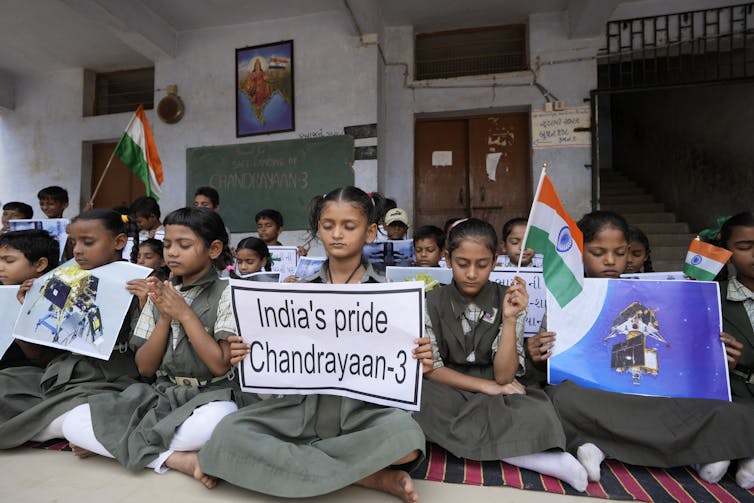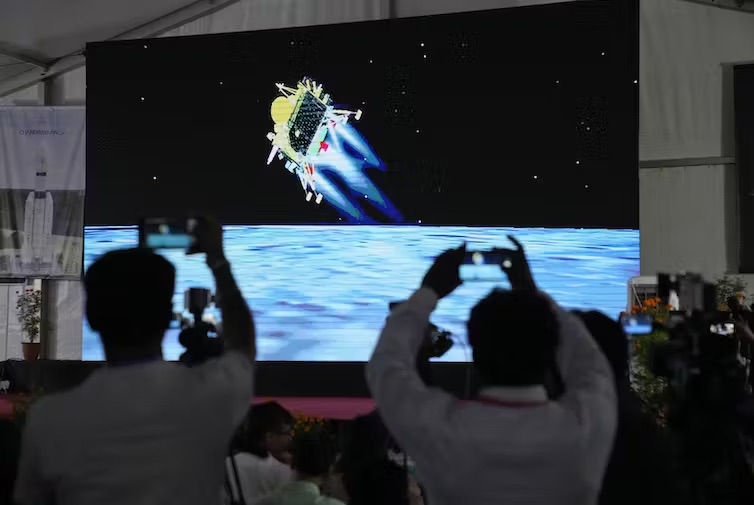India made history as the first country to land near the south pole of the Moon with its Chandrayaan-3 lander on Aug. 23, 2023. This also makes it the first country to land on the Moon since China in 2020.
India is one of several countries — including the U.S. with its Artemis program — endeavoring to land on the Moon. The south pole of the Moon is of particular interest, as its surface, marked by craters, trenches and pockets of ancient ice, hasn’t been visited until now.
The Conversation U.S. asked international affairs expert Mariel Borowitz about this Moon landing’s implications for both science and the global community.
Why are countries like India looking to go to the Moon?
Countries are interested in going to the Moon because it can inspire people, test the limits of human technical capabilities and allow us to discover more about our solar system.
The Moon has a historical and cultural significance that really seems to resonate with people – anyone in the world can look up at the night sky, see the Moon and understand how amazing it is that a spacecraft built by humans is roaming around the surface.
The Moon also presents a unique opportunity to engage in both international cooperation and competition in a peaceful, but highly visible, way.
The fact that so many nations – the United States, Russia, China, India, Israel – and even commercial entities are interested in landing on the Moon means that there are many opportunities to forge new partnerships.
These partnerships can allow nations to do more in space by pooling resources, and they encourage more peaceful cooperation here on Earth by connecting individual researchers and organizations.
There are some people who also believe that exploration of the Moon can provide economic benefits. In the near term, this might include the emergence of startup companies working on space technology and contributing to these missions. India has seen a surge in space startups recently.
Eventually, the Moon may provide economic benefits based on the natural resources that can be found there, such as water, helium-3 and rare Earth elements.
Are we seeing new global interest in space?
Over the last few decades, we’ve seen a significant increase in the number of nations involved in space activity. This is very apparent when it comes to satellites that collect imagery or data about the Earth, for example. More than 60 nations have been involved in these types of satellite missions. Now we’re seeing this trend expand to space exploration, and particularly the Moon.

In some ways, the interest in the Moon is driven by similar goals as in the first space race in the 1960s – demonstrating technological capabilities and inspiring young people and the general public. However, this time it’s not just two superpowers competing in a race. Now we have many participants, and while there is still a competitive element, there is also an opportunity for cooperation and forging new international partnerships to explore space.
Also, with all these new actors and the technical advances of the last 60 years, there is the potential to engage in more sustainable exploration. This could include building Moon bases, developing ways to use lunar resources and eventually engaging in economic activities on the Moon based on natural resources or tourism.
How does India’s mission compare with Moon missions in other countries?
India’s accomplishment is the first of its kind and very exciting, but it’s worth noting that it’s one of seven missions currently operating on and around the Moon.

In addition to India’s Chandrayaan-3 rover near the south pole, there is also South Korea’s Pathfinder Lunar Orbiter, which is studying the Moon’s surface to identify future landing sites; the NASA-funded CAPSTONE spacecraft, which was developed by a space startup company; and NASA’s Lunar Reconnaissance Orbiter. The CAPSTONE craft is studying the stability of a unique orbit around the Moon, and the Lunar Reconnaissance Orbiter is collecting data about the Moon and mapping sites for future missions.
Also, while India’s Chandrayaan-2 rover crashed, the accompanying orbiter is still operational. China’s Chang’e-4 and Chang’e-5 landers are still operating on the Moon as well.
Other nations and commercial entities are working to join in. Russia’s Luna-25 mission crashed into the Moon three days before the Chandrayaan-3 landed, but the fact that Russia developed the rover and got so close is still a significant achievement.
The same could be said for the lunar lander built by the private Japanese space company ispace. The lander crashed into the Moon in April 2023.
Why choose to explore the south pole of the Moon?
The south pole of the Moon is the area where nations are focused for future exploration. All of NASA’s 13 candidate landing locations for the Artemis program are located near the south pole.
This area offers the greatest potential to find water ice, which could be used to support astronauts and to make rocket fuel. It also has peaks that are in constant or near-constant sunlight, which creates excellent opportunities for generating power to support lunar activities.![]()







